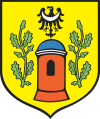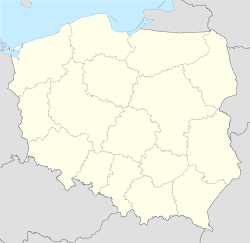- Niemcza
-
Niemcza 
Flag
Coat of armsCoordinates: 50°43′N 16°50′E / 50.717°N 16.833°E Country  Poland
PolandVoivodeship Lower Silesian County Dzierżoniów Gmina Niemcza Town rights 1282 Government - Mayor Grzegorz Kosowski Area - Total 19.81 km2 (7.6 sq mi) Population (2007) - Total 3,085 - Density 155.7/km2 (403.3/sq mi) Website http://www.um.niemcza.pl Niemcza [ˈɲemt͡ʂa] (German: Nimptsch) is a town in Dzierżoniów County, Lower Silesian Voivodeship, in south-western Poland. It is the seat of the administrative district (gmina) called Gmina Niemcza.
The town lies on the Ślęza River, approximately 20 kilometres (12 mi) east of Dzierżoniów, and 48 kilometres (30 mi) south of the regional capital Wrocław.
From 1975 to 1998 Niemcza was in Wałbrzych Voivodeship.
Contents
History
Niemcza is historically one of the most important towns of Silesia.[1][2] The oldest traces date back to the Bronze age. Between 1000 and 800 B.C. people of the Lusatian culture fortified the so called "city hill" and incorporated this fortification into their Silesian defence system. This fort was probably destroyed during a battle against the Scythian around 500 BC. Members of the Germanic Silingi tribe who did not participate in the Migration Period but stayed in Silesia chose the place in the 4th century as their fortified center of a Germanic settlement area between "mons Silencii" (Ślęża) and the river "Selenca" (Ślęza).[1] Slavs arrived after the 6th century and called this place "Nemci" ( = mute, metaphorically "those who do not speak our language").[2][3] Thietmar of Merseburg later described "Nemzi" as "eo quod a nostris olim sitcondita, dicta" (Nemzi is called like that because it is, according to reports, founded by our people).[3][4] The settlement was expanded and evolved into the center of the Ślężanie district.
In early times Niemcza became a important base in Bohemias fight for Silesia. After 990 it was seized by Poland and withstood both emperor Henry II. in 1017 and a major offensive of Bohemia in 1093.[3] After 1155 it became the center of a Piast castellany district. This preurban civitas consisted of a settlement enclosed by imposing ramparts in great-moravian design (the only one in Silesia), the castellany castle with St. Peter chapel, first mentioned in 1288/95, and a market place around St. Adalbert church, one of the oldest churches of Silesia, outside and to the west of the ramparts. The area was surrounded by several manors.
The German Ostsiedlung reached Niemcza and the surrounding area already in 1210.[3] The settlement however grew only slow as the new German town was founded directly on the soil of the cramped old Polish urbs, whereas the more spacious market place around St. Adalbert was remodeled to a village. Remarkable was the establishment of the parish church St. Marien, which in 1295 was assigned to both Poles and Germans for shared and separate usage. Before 1300 a new city wall was built, which is in parts preserved. At the same time the wooden castellany castle was replaced by a stone castle, and a city hall was first mentioned in 1474.
With the partition of the Duchy of Wrocław/Breslau in 1311 the town passed to the Duchy of Brzeg/Brieg. In 1322 both the town and municipal area (Weichbild) became a pledged possession of the Duchy of Świdnica/Schweidnitz, whose duke Bolko I. used the strategic position of Niemcza/Nimptsch in his fight against Bohemia. After his duchy passed to Bohemia in 1392 the town came back to the duchy of Brieg. The Hussites seized Nimptsch in 1430 and held the town for several years. After six unsuccessful sieges Nimptsch was returned in 1434 and razed to the ground by the Silesians.
In 1494 the administration of the municipal area was moved to Schlottnitz. Nimptsch, which was equipped below average, enclosed by noble properties, on the periphery of the municipal area, in the extreme western corner of the duchy and close to the far more successful foundations of Reichenbach (Dzierżoniów) and Frankenstein (Ząbkowice Śląskie), could never overcome such backlashes. A moderate recovery, marked by the reconstruction of the town wall, the modernisation of the,never used, ducal residence, the rebuilding of St. Adalbert as the Protestant church St. George in 1612 and the awarding of several town rights, was stopped by the Thirty Years War. In 1635 Daniel Casper von Lohenstein was born in the residence, the only building not destroyed during this war. Only 12 out of 103 landlords of Nimpsch survived firestorm and pest.
The slow rebuilding, with the help of immigrated Bohemians, was again stopped by several major fires, which destroyed the town hall and parts of the residence. After the extinction of the local Piasts in 1675 the counter-reformation obtained the tension-filled reestablishment of a Catholic commune. At the same time Nimptsch became a center of sacred music thanks to Protestant cantor Johann Heinrich Quiel.
After the defeat of Nazi Germany Nimptsch passed to Poland and was renamed to Niemcza. The German inhabitants were expelled[5] and the town was resettled with Poles. The city wasn't destroyed in World War II. Of the three preserved historical buildings at that time the Renaissance octagon of the residence and the Catholic Church are decayed and demolished. St. George is preserved, as well as the late Baroque residential buildings on the market place (rynek).
Population
year population 1740 1150 1787 1256 1825 2182 1905 2216 1939 3523 (16,24 km²) 1961 3557 (19,25 km²) 1970 3772 2006 3121 2007 3085 Notable people
International relations
Twin towns — Sister cities
Niemcza is twinned with:
 Gladenbach in Germany
Gladenbach in Germany Letohrad in Czech Republic
Letohrad in Czech Republic Monteux in France
Monteux in France
References
Bibliography
- Weczerka, Hugo (2003). Handbuch der historischen Stätten: Schlesien. Stuttgart: Alfred Kröner Verlag. ISBN 3-520-31602-1.
- Petry, Ludwig; Josef Joachim Menzel, Winfried Irgang (2000). Geschichte Schlesiens. Band 1: Von der Urzeit bis zum Jahre 1526. Stuttgart: Jan Thorbecke Verlag Stuttgart. ISBN 3-7995-6341-5.
- Thum, Gregor (2006). Die fremde Stadt. Breslau nach 1945. München: Random House. ISBN 3-570-55017-6, 987-3-570-55017-5.
Notes
- ^ a b Weczerka, p.361
- ^ a b "Official website of the city
- ^ a b c d Weczerka, p.362
- ^ Petry, p.76
- ^ Die vollständige Entfernung der deutschen Bevölkerung aus Polen war nur auf dem Weg der organisierten Massenaussiedlung zu erreichen. Sie begann im Winter 1945/46 und brachte bis Ende 1945 über 3 Millionen Menschen in die britische und sowjetische Besatzungszone. Ende 1947 war die Aussiedlung im Wesentlichen abgeschlossen, auch wenn 1948 bis 1950 noch einmal rund 140.000 Deutsche aus Polen ausgesiedelt wurden - vor allem jene, denen als unentbehrliche Arbeitskräfte die Ausreise bis dahin verweigert worden war. Thum, p.118
Coordinates: 50°43′N 16°50′E / 50.717°N 16.833°E
Town and seat Niemcza
Villages Categories:- Cities and towns in Lower Silesian Voivodeship
- Dzierżoniów County
- Cities in Silesia
Wikimedia Foundation. 2010.



